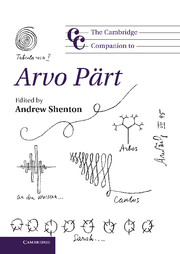Book contents
- Frontmatter
- 1 Introduction: the essential and phenomenal Arvo Pärt
- 2 A narrow path to the truth: Arvo Pärt and the 1960s and 1970s in Soviet Estonia
- 3 Perspectives on Arvo Pärt after 1980
- 4 Musical archetypes: the basic elements of the tintinnabuli style
- 5 Analyzing Pärt
- 6 Arvo Pärt: in his own words
- 7 Bells as inspiration for tintinnabulation
- 8 Arvo Pärt and spirituality
- 9 The minimalism of Arvo Pärt: an ‘antidote’ to modernism and multiplicity?
- 10 Arvo Pärt in the marketplace
- Appendix A Radiating from silence: the works of Arvo Pärt seen through a musician's eyes
- Appendix B Greatly sensitive: Alfred Schnittke in Tallinn
- Appendix C Remembering Heino Eller
- Appendix D Acceptance speech for the International Bridge Prize of the European City of Görlitz
- Appendix E Acceptance speech for the Léonie Sonning Music Prize 2008
- Appendix F Works list
- Notes
- Select bibliography
- Cambridge Companions to Music
- Index
1 - Introduction: the essential and phenomenal Arvo Pärt
Published online by Cambridge University Press: 28 September 2012
- Frontmatter
- 1 Introduction: the essential and phenomenal Arvo Pärt
- 2 A narrow path to the truth: Arvo Pärt and the 1960s and 1970s in Soviet Estonia
- 3 Perspectives on Arvo Pärt after 1980
- 4 Musical archetypes: the basic elements of the tintinnabuli style
- 5 Analyzing Pärt
- 6 Arvo Pärt: in his own words
- 7 Bells as inspiration for tintinnabulation
- 8 Arvo Pärt and spirituality
- 9 The minimalism of Arvo Pärt: an ‘antidote’ to modernism and multiplicity?
- 10 Arvo Pärt in the marketplace
- Appendix A Radiating from silence: the works of Arvo Pärt seen through a musician's eyes
- Appendix B Greatly sensitive: Alfred Schnittke in Tallinn
- Appendix C Remembering Heino Eller
- Appendix D Acceptance speech for the International Bridge Prize of the European City of Görlitz
- Appendix E Acceptance speech for the Léonie Sonning Music Prize 2008
- Appendix F Works list
- Notes
- Select bibliography
- Cambridge Companions to Music
- Index
Summary
Arvo Pärt is by all criteria an extremely successful composer. He has composed many pieces that have garnered both critical and popular acclaim, and he has received prestigious commissions and worked with some of the greatest musicians of our time. He has received numerous honors and awards, and the diversity of these accolades demonstrates the breadth of his appeal, from the 1989 Grammy Nomination for Passio, in the ‘Best Contemporary Composition’ category, to a Classic BRIT Award for ‘Composer of the Year’ in 2011. His audience is diverse and international, with performances of his music and record sales all over the world. His hugely popular recordings have been used in both film and television, including Oscar-winning movies such as Fahrenheit 9/11 (2004) and There Will Be Blood (2007), and have also been appropriated by the general public and used in video pieces on social media platforms such as YouTube and Vimeo. His ability to transcend genres is demonstrated in musicians as disparate as Björk, Keith Jarrett, Radiohead, and Lupe Fiasco, all of whom cite him as an influence. His music has had a profound effect on many visual artists who draw inspiration from what they hear; it is frequently choreographed to great effect (as seen, for example, in Helen Pickett's 2011 work with Boston Ballet), and is being used in pioneering work with people with learning disabilities and with palliative care for the sick and dying.
- Type
- Chapter
- Information
- The Cambridge Companion to Arvo Pärt , pp. 1 - 9Publisher: Cambridge University PressPrint publication year: 2012

